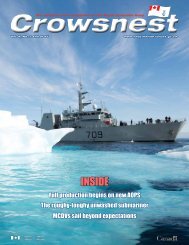Create successful ePaper yourself
Turn your PDF publications into a flip-book with our unique Google optimized e-Paper software.
2.2 Undersea Communications <strong>and</strong> Minerals<br />
While we do not have any precise knowledge <strong>of</strong> <strong>the</strong> mineral wealth that lies in <strong>the</strong> seabed,<br />
technology is making us better informed. In <strong>the</strong> past, extraction <strong>of</strong> most minerals that had been<br />
identified was ei<strong>the</strong>r impossible or uneconomical. As a result <strong>of</strong> technological advances, however,<br />
that situation is changing. Even if <strong>the</strong> costs are still prohibitively high today, <strong>the</strong>y are unlikely to<br />
remain so forever. <strong>Environment</strong>al concerns will continue to make exploitation <strong>of</strong> deep oceanic<br />
mineral resources controversial, but <strong>the</strong>ir market value could make development increasingly<br />
attractive. Already, extraction <strong>of</strong> some <strong>of</strong> <strong>the</strong>se resources has grown exponentially. This is<br />
especially evident in <strong>the</strong> field <strong>of</strong> energy, <strong>and</strong> oil <strong>and</strong> gas production is <strong>the</strong> world’s biggest marine<br />
industry, worth more than US$300 billion annually. 35 Outside <strong>of</strong> North American waters, <strong>the</strong><br />
number <strong>of</strong> deep water oil wells has increased four-fold since 2000. Current forecasts indicate that<br />
by 2035, up to 11 percent <strong>of</strong> global production could come from deep-sea drilling. 36 <strong>The</strong>re is also<br />
an expectation that <strong>the</strong> minerals industry is set to exp<strong>and</strong> into <strong>the</strong> ocean depths. 37 Large deposits<br />
<strong>of</strong> minerals, such as gold, silver, zinc <strong>and</strong> copper, are believed to exist in <strong>the</strong> seabed. As global<br />
population increases <strong>and</strong> human development levels rise, so too will <strong>the</strong> dem<strong>and</strong> for natural<br />
resources. <strong>Future</strong> or planned exploitation <strong>of</strong> those minerals found on <strong>the</strong> seafloor will naturally<br />
lead governments <strong>and</strong> private industry to pay greater attention to <strong>the</strong>ir development.<br />
In recent years, we have increasingly come to think <strong>of</strong> <strong>the</strong> ocean depths as a resource treasure<br />
trove but, while less widely appreciated, we also rely on <strong>the</strong>m to facilitate communications. By<br />
2014, <strong>the</strong>re were 213 submarine cable systems in operation, totalling 877,122 kilometres. All<br />
regions <strong>of</strong> <strong>the</strong> globe are linked directly or indirectly via <strong>the</strong>se systems. With lower operating costs<br />
than satellites, undersea cables provide 97 percent <strong>of</strong> global data traffic <strong>and</strong> are essential to <strong>the</strong><br />
operation <strong>of</strong> <strong>the</strong> internet, as well as <strong>the</strong> communications <strong>and</strong> international financial industries, not<br />
to mention national security. <strong>The</strong> Society for Worldwide Interbank Financial Telecommunications<br />
(SWIFT) transmits 15 million messages per day via submarine cables to more than<br />
8,000 financial institutions in 208 countries or organizations. <strong>The</strong> US Clearing House Interbank<br />
Payments System (CHIPS) processes over US$1 trillion per day in transactions to 22 countries.<br />
Undersea cables also facilitate <strong>the</strong> transmission <strong>of</strong> electrical power; between mainl<strong>and</strong> Australia<br />
<strong>and</strong> Tasmania, for example, <strong>and</strong> <strong>the</strong>y make possible <strong>the</strong> at-sea wind farms operated by Denmark,<br />
Germany <strong>and</strong> <strong>the</strong> United Kingdom. 38 And last, submarine cables are useful as a tool to advance<br />
our knowledge <strong>of</strong> <strong>the</strong> oceans. As part <strong>of</strong> a joint US-Canada project, <strong>the</strong>y provide scientists with<br />
35 Assaf Harel, “Preventing Terrorist Attacks on Offshore Platforms: Do States Have Sufficient Legal<br />
Tools”, Harvard National Security Journal, Vol. 4, No. 1, 2012, p. 131.<br />
36 Martinage, “Under <strong>the</strong> Sea: <strong>The</strong> Vulnerability <strong>of</strong> <strong>the</strong> Commons”, pp. 117-123.<br />
37 In May 2014, it was announced that a Canadian company could be involved in <strong>the</strong> world’s first deep-sea<br />
mine <strong>of</strong>f <strong>the</strong> coast <strong>of</strong> New Guinea. See Ariana Kaknevicius, “Canadian mining company could be involved<br />
in world’s first deep-sea mine”, Canadian Geographic (online), 13 May 2014 <strong>and</strong> Gemima Harvey, “<strong>The</strong><br />
Deep-sea Resources Rush”, <strong>The</strong> Diplomat, 20 August 2013. <strong>The</strong> major focus <strong>of</strong> current efforts is<br />
manganese nodules (located below 4,000 metres), gas hydrates (between 350 <strong>and</strong> 5,000 metres), cobalt<br />
crusts (found on <strong>the</strong> sides <strong>of</strong> undersea mountain ranges between 1,000 <strong>and</strong> 3,000 metres), <strong>and</strong> sulphides <strong>and</strong><br />
sulphide muds (between 500 <strong>and</strong> 4,000 metres). See “Marine minerals”, World Ocean Review, no date<br />
[accessed on 7 September 2014 at http://worldoceanreview.com/en/wor-1/energy/marine-minerals/].<br />
38 Douglas Burnett, Tara M. Davenport <strong>and</strong> Robert C. Beckman, “Why Submarine Cables?” in Douglas Burnet,<br />
Robert C. Beckman <strong>and</strong> Tara M. Davenport (eds.), Submarine Cables: <strong>The</strong> H<strong>and</strong>book <strong>of</strong> Law <strong>and</strong> Policy<br />
(Martinius Nijh<strong>of</strong>f: Leiden, 2014), pp. 1–2.<br />
DRDC-RDDC-2016-R085 9




